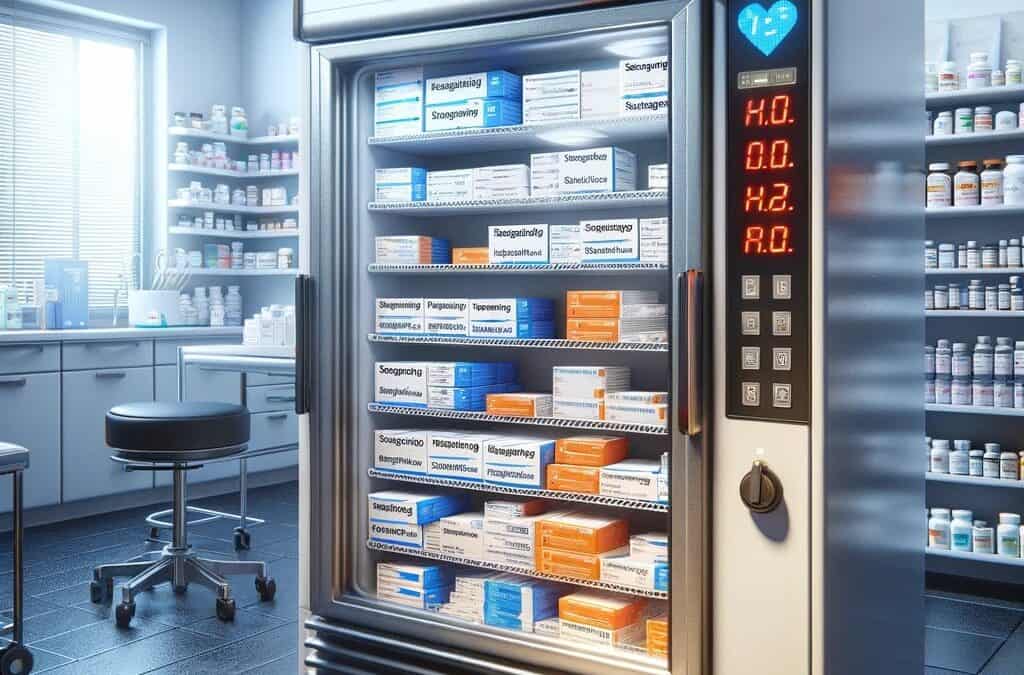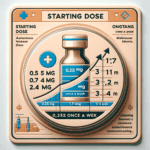
Why Does Semaglutide Need To Be Refrigerated?
Why Does Semaglutide Need To Be Refrigerated? Semaglutide is a medication that has gained significant attention in recent years due to its effectiveness in managing type 2 diabetes.
It belongs to a class of drugs called glucagon-like peptide-1 receptor agonists (GLP-1 RAs), which work by stimulating the release of insulin and reducing the production of glucagon in the body. This helps to regulate blood sugar levels and improve glycemic control.
Key Takeaways
- Semaglutide is a medication that requires refrigeration to maintain its efficacy.
- The chemical properties of semaglutide make it susceptible to degradation at higher temperatures.
- Proper refrigeration is crucial in maintaining the effectiveness of semaglutide.
- Failure to refrigerate semaglutide can lead to reduced efficacy and potential health risks.
- To ensure proper storage, semaglutide should be kept in the refrigerator and not frozen.
The Importance of Refrigeration in Medications
Refrigeration plays a crucial role in the storage and preservation of various medications, including semaglutide. Many medications, especially those that are biologically derived or contain sensitive compounds, require refrigeration to maintain their efficacy and safety. The cold temperature helps to slow down chemical reactions and microbial growth, ensuring that the medication remains stable and effective for a longer period.
Maintaining the efficacy and safety of medications is of utmost importance as it directly impacts patient health outcomes. If medications are not stored properly, they may degrade or become contaminated, leading to reduced effectiveness or even harmful side effects. Why Does Semaglutide Need To Be Refrigerated? This is particularly critical for medications like semaglutide, which are used to manage chronic conditions such as diabetes, where consistent and reliable treatment is essential for long-term health.
What is Semaglutide?
Semaglutide is a GLP-1 RA that has been approved by regulatory authorities for the treatment of type 2 diabetes. It is available in both injectable and oral formulations, providing flexibility for patients in choosing their preferred method of administration. Semaglutide works by mimicking the action of a naturally occurring hormone called glucagon-like peptide-1 (GLP-1), which helps regulate blood sugar levels.
In addition to its glucose-lowering effects, semaglutide has also shown benefits in terms of weight loss. This makes it an attractive option for patients who struggle with both diabetes management and weight control. The medication has been extensively studied in clinical trials and has demonstrated superior efficacy compared to other GLP-1 RAs, making it a promising treatment option for individuals with type 2 diabetes.
Why Does Semaglutide Need to be Refrigerated?
| Question | Why Does Semaglutide Need to be Refrigerated? |
|---|---|
| Drug Name | Semaglutide |
| Drug Type | GLP-1 receptor agonist |
| Storage Temperature | 2°C to 8°C (36°F to 46°F) |
| Reason for Refrigeration | To maintain the stability and potency of the drug |
| Duration of Refrigeration | From manufacturing to dispensing to the patient |
| Consequences of Improper Storage | Reduced efficacy, increased risk of adverse effects, and potential harm to the patient |

Semaglutide Is A Peptide
Semaglutide, like many other medications, requires refrigeration due to its chemical properties and the need to maintain its stability. The active ingredient in semaglutide is a peptide, which is a chain of amino acids. Peptides are generally more susceptible to degradation and loss of potency compared to small molecule drugs. Refrigeration helps slow down the degradation process by reducing the rate of chemical reactions that can lead to the breakdown of the peptide structure.
Furthermore, semaglutide is formulated as a solution for injection, which means it contains additional excipients and preservatives to ensure its stability and sterility. These excipients may also be sensitive to temperature variations, and refrigeration helps maintain their integrity. By keeping semaglutide at a controlled temperature, it is possible to extend its shelf life and ensure that each dose retains its full therapeutic potential.
The Chemical Properties of Semaglutide
Semaglutide is a long-acting GLP-1 RA that has been modified to increase its half-life in the body. This modification involves the addition of fatty acid chains to the peptide structure, which enhances its stability and slows down its clearance from the bloodstream. The fatty acid chains also contribute to the hydrophobic nature of semaglutide, making it less soluble in water.
The hydrophobic nature of semaglutide affects its stability and solubility, making it more prone to aggregation or precipitation when exposed to certain conditions. This can lead to reduced bioavailability and potentially impact its therapeutic efficacy. Refrigeration helps mitigate these risks by maintaining a consistent temperature that minimizes the likelihood of aggregation and precipitation.
The Impact of Temperature on Semaglutide
Temperature plays a critical role in the stability and effectiveness of semaglutide. High temperatures can accelerate the degradation of the peptide structure, leading to a loss of potency. On the other hand, freezing temperatures can cause physical changes in the formulation, such as the formation of ice crystals, which can damage the delicate peptide structure.
Why Does Semaglutide Need To Be Refrigerated? It is important to note that even short-term exposure to unfavorable temperatures can have a detrimental effect on semaglutide. This is why proper storage and handling are crucial to ensure that the medication remains within the recommended temperature range throughout its shelf life. Deviations from the recommended storage conditions can compromise the quality and efficacy of semaglutide, potentially putting patients at risk.
Why Does Semaglutide Need To Be Refrigerated? The Role of Refrigeration in Maintaining Semaglutide’s Efficacy
Refrigeration is essential for maintaining semaglutide’s efficacy by providing a controlled environment that minimizes degradation and maintains its stability. The cold temperature helps to slow down chemical reactions, reducing the rate of peptide degradation and preserving its therapeutic activity. By keeping semaglutide refrigerated, healthcare providers can ensure that each dose delivers the intended therapeutic effect.
In addition to preserving efficacy, refrigeration also helps maintain the sterility of semaglutide. Bacterial growth can be inhibited at low temperatures, reducing the risk of contamination and infection. This is particularly important for injectable medications like semaglutide, where any microbial contamination can have serious consequences for patient safety.
The Risks of Not Refrigerating Semaglutide
Why Does Semaglutide Need To Be Refrigerated? Failure to refrigerate semaglutide can have significant consequences on its efficacy and safety. Exposure to high temperatures can lead to accelerated degradation, resulting in reduced potency and compromised therapeutic effects. Patients who rely on semaglutide for diabetes management may experience inadequate blood sugar control if the medication has been improperly stored.
Furthermore, the risk of contamination increases when semaglutide is not refrigerated. Bacterial growth can occur at higher temperatures, and if the medication becomes contaminated, it can lead to serious infections or other adverse reactions. Patients who are already dealing with the challenges of managing diabetes should not have to worry about the integrity of their medication due to improper storage.
How to Properly Store Semaglutide

How to Properly Store Semaglutide
Proper storage of semaglutide is crucial to ensure its effectiveness and safety. The medication should be stored in a refrigerator between 2°C and 8°C (36°F and 46°F). It is important to avoid freezing semaglutide, as this can cause irreversible damage to the formulation. Additionally, semaglutide should be protected from light by keeping it in its original packaging or using an opaque container.
When transporting semaglutide, it is essential to use a cooler bag or insulated container to maintain the recommended temperature range. This is particularly important during hot weather or when traveling long distances. It is also advisable to check the expiration date before using semaglutide and discard any expired or damaged vials.
Why Does Semaglutide Need To Be Refrigerated? The Future of Semaglutide and Refrigeration
As technology continues to advance, there may be potential advancements in the storage and handling of semaglutide. Researchers are exploring alternative formulations and delivery methods that may eliminate the need for refrigeration or provide more convenient options for patients. These advancements could improve patient adherence and reduce the burden associated with refrigeration requirements.
However, it is important to note that any changes in storage requirements should be supported by rigorous scientific evidence and regulatory approval. Patient safety should always be the top priority, and any modifications to storage conditions must ensure that the medication remains stable, effective, and safe for use.
FAQs

The Importance of Semaglutide Refrigeration
What is Semaglutide?
Semaglutide is a medication used to treat type 2 diabetes. It is a glucagon-like peptide-1 (GLP-1) receptor agonist that helps regulate blood sugar levels.
Why Does Semaglutide Need To Be Refrigerated?
Semaglutide requires refrigeration because it is a protein-based medication that can degrade and lose its effectiveness if exposed to high temperatures. Refrigeration helps to maintain the stability and potency of the medication.
What temperature should Semaglutide be stored at?
Semaglutide should be stored in a refrigerator at a temperature between 36°F and 46°F (2°C and 8°C). It should not be frozen or exposed to temperatures above 86°F (30°C).
What happens if Semaglutide is not refrigerated?
If Semaglutide is not refrigerated, it can degrade and lose its effectiveness. This can lead to inadequate blood sugar control and potentially serious health complications.
How long can Semaglutide be stored at room temperature?
Semaglutide should not be stored at room temperature. It should be refrigerated at all times to maintain its stability and potency.
Can Semaglutide be stored in a cooler or insulated bag?
Semaglutide can be stored in a cooler or insulated bag as long as the temperature is maintained between 36°F and 46°F (2°C and 8°C). It should not be frozen or exposed to temperatures above 86°F (30°C).
What should I do if my Semaglutide has been exposed to high temperatures?
If your Semaglutide has been exposed to high temperatures, it may have degraded and lost its effectiveness. Contact your healthcare provider or pharmacist for guidance on whether to continue using the medication or to obtain a replacement.
Conclusion of Why Does Semaglutide Need To Be Refrigerated?
In conclusion, proper storage and handling of semaglutide are crucial to maintain its efficacy and safety. Refrigeration plays a vital role in preserving the stability of semaglutide, ensuring that each dose delivers the intended therapeutic effect. Deviations from the recommended storage conditions can compromise the quality and potency of semaglutide, potentially putting patients at risk.
Healthcare providers and patients must be diligent in following the storage instructions provided with semaglutide. This includes refrigerating the medication within the recommended temperature range, protecting it from light, and discarding any expired or damaged vials. By adhering to these guidelines, patients can have confidence in the effectiveness and safety of their semaglutide treatment, ultimately improving their overall health outcomes.






